Robocalls have been on the rise in the U.S. for years, prompting the FCC to launch a new anti-robocalling initiative in June 2019. Ajit Pai, who heads the FCC, has claimed the new policies will help consumers, ‘Stem the flow of scam robocalls,” the initiative has been met with widespread criticism. Much of this hinges on the assertion that the plan “has no teeth;” in other words, while it puts several directives in place, it lacks the ability to actually enforce any of them. Furthermore, it’s unclear how the new technology allowed under the directive will be funded or implemented.
This makes a huge difference to consumers, as Americans already spend an incredible amount of time on their phones. The average phone carrier in the U.S. spends over four hours on a device per day, to be exact, and this massive increase in usage has come along with a big increase in robocalls. These unwanted calls, which range from debt collectors to imposter scams, occurred approximately 26.3 billion times in the U.S. in 2018.
To get a better handle on what these calls are about and who gets targeted, we analyzed data from the Federal Trade Commission to understand better robocalls registered around the U.S. over time. In addition to confirming the findings already reported in numerous studies on the scope and scale of robocalls, we learned about the efficacy of do not call lists, the number of complaints about robocalls, and the biggest states for unwanted, robotic voice spam. Read on to see how your region compares – and what’s going on at the other end of your phone.
Caller Complaints
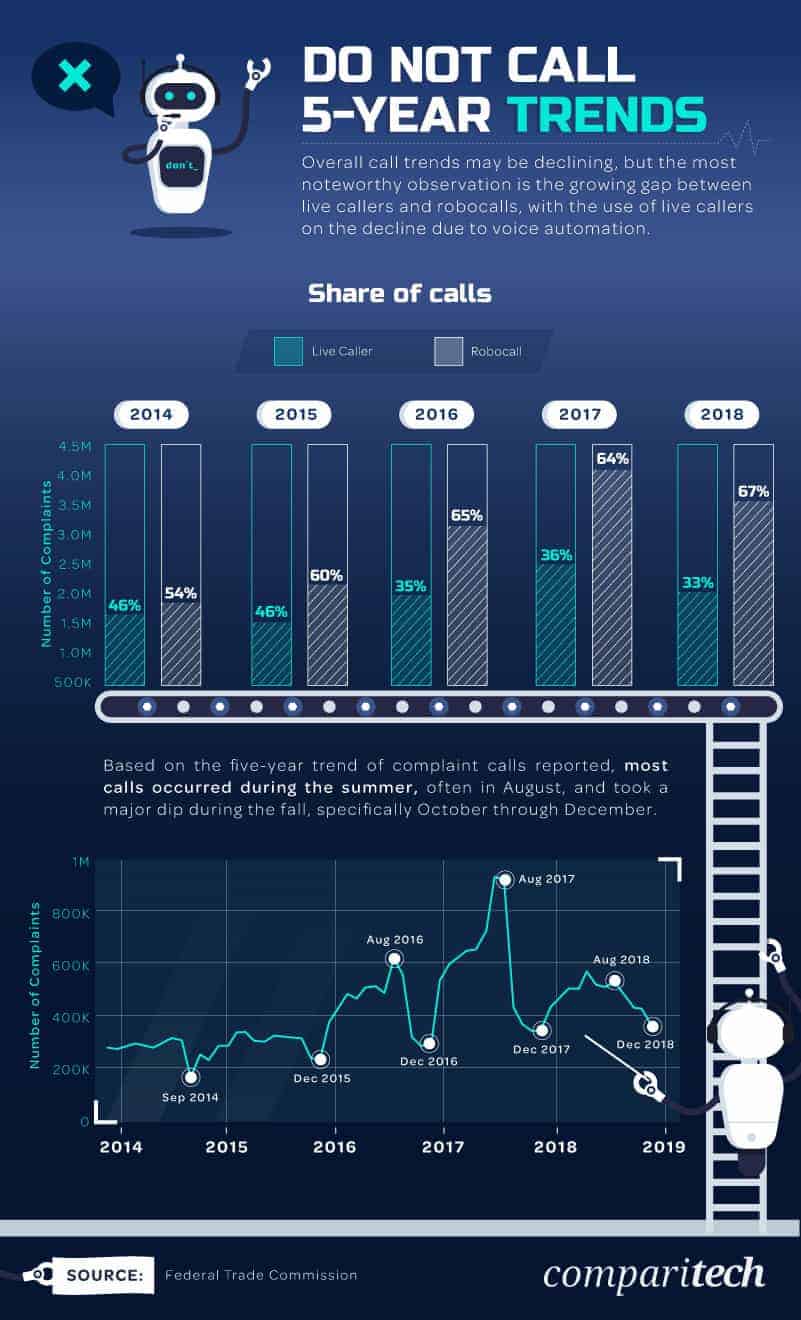
The National Do Not Call Registry is an official government registry that allows consumers to avoid unsolicited sales calls. But even those on the registry might receive a call sometimes, and millions of other Americans who are not on the list deal with telemarketers constantly – in fact, most Americans receive at least one robocall per day.
We examined five-year trends from 2014 to 2018 on both live callers and robocalls to see how they’ve changed in frequency over time – and whether Americans are complaining.
As it turns out, complaints to the FTC about robocalls are generally rising. Robocall complaints grew by 165% between 2014 and 2017, reaching a peak of 4.5 million annually before slightly decreasing to about 3.8 million in 2018. Robocalls were more prevalent than complaints about live callers, possibly because the human element is removed.
But on the calendar of monthly complaints, some months stood out more than others. Most complaints about spam calls occurred during the summer – often in August – before declining during the fall, between October and December. August of 2017, in particular, saw a peak for complaints – 939,000 people reported calls to the FTC.
Spam Locations
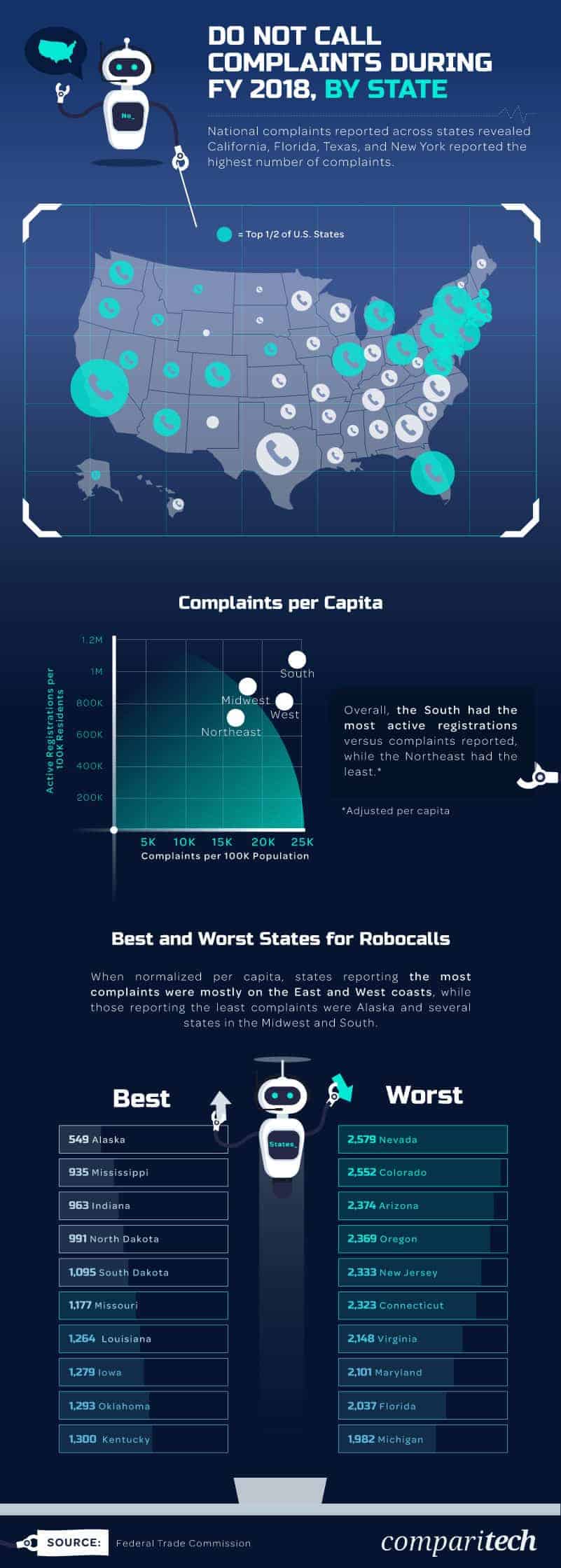
Spam calls certainly happen everywhere in the U.S., but where are they happening the most? Our analysis suggests that the top states for complaints about spam calls were Nevada, Colorado, Arizona, Oregon, and New Jersey. Users in these states dealt with more than double the robocalls per capita than many of the least-called states, and nearly five times the rate of those received in Alaska.
Those living in the South were more likely to complain about spam calls and, therefore, perhaps more likely to receive them. Meanwhile, those in the Northeast were the least likely to complain based on our data.
Spam Topics
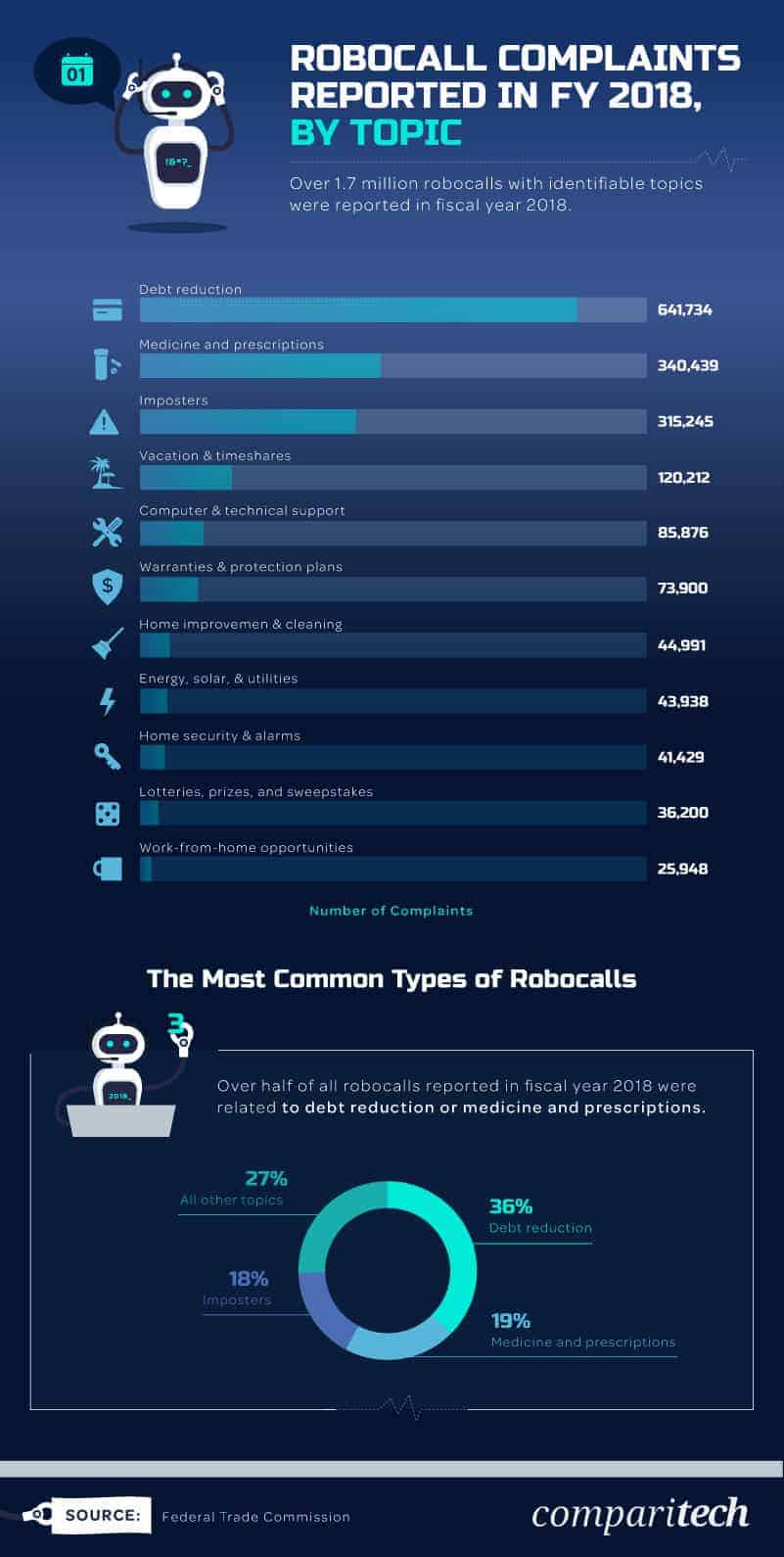
Even spam comes with a topic of conversation, apparently. Of robocalls reported to the FTC in the fiscal year 2018, more than 1.7 million included identifiable topics. By far, the most common topic identified was debt reduction, with more than 641,700 calls discussing it. Calls related to medical care or medical bills, imposter callers, vacations and timeshares, computers and technical support, and warranties and protection plans were also leading topics when it came to spam calls in 2018.
In general, spam calls didn’t appear to have much diversity – the top three topics mentioned made up 73% of all reported robocalls in 2018. And even imposter callers didn’t put in that much effort it seems: Only 20% of calls made by imposters actually involved a live caller instead of a robot.
Who’s Calling?
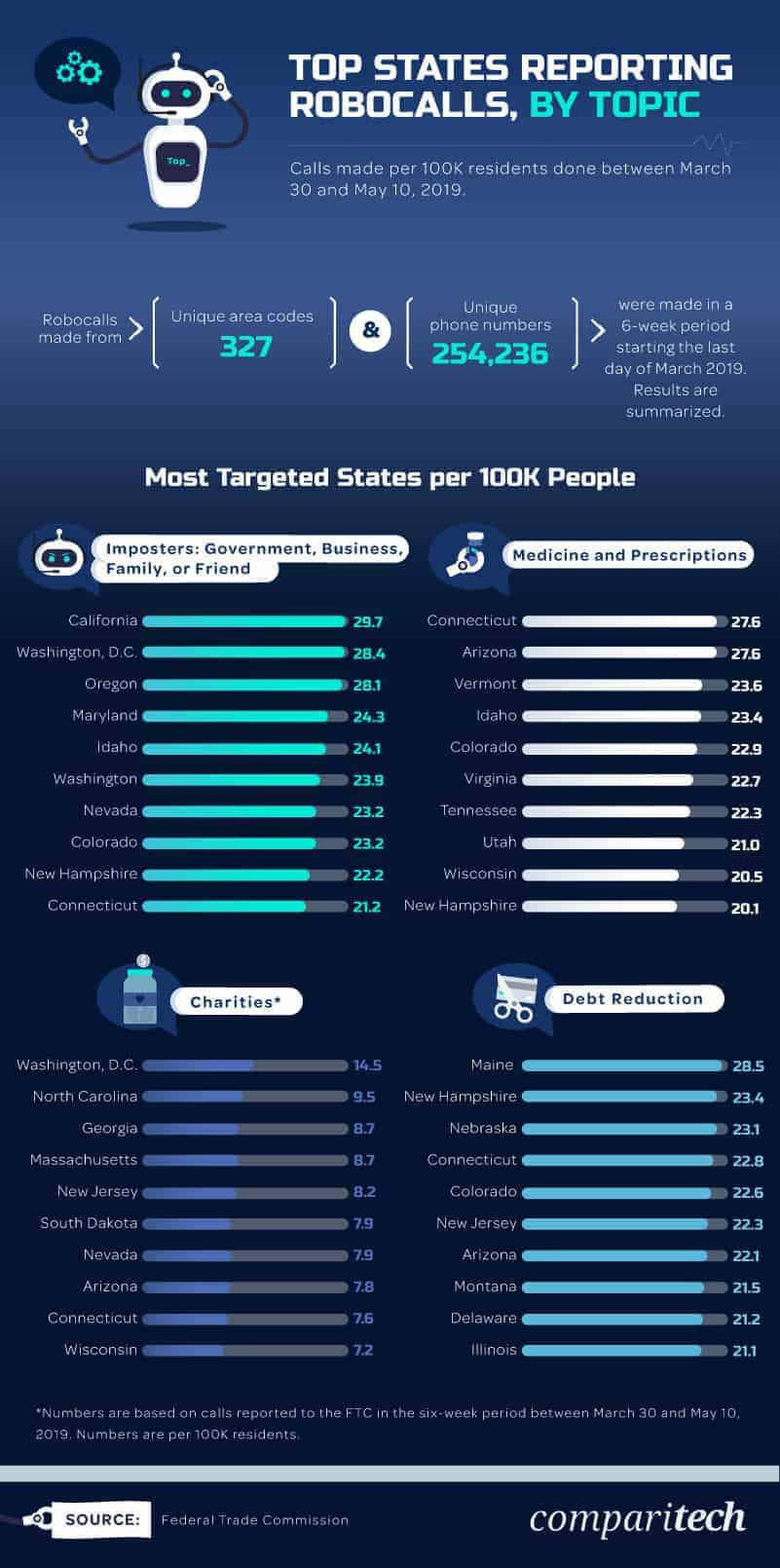
Robocalls are known to be annoying, disruptive, and frequent – some individuals have reported receiving them as much as six times a day. This point is illustrated by everything from the major increases in FCC complaints to the uptick in Google searches for ‘phone spam’ over the last five years, but this still says little about the nature of the calls themselves or what individuals or entities might be behind the dramatic recent increases.
According to our analysis, robocalls made during a six-week span in 2019 came from 327 unique area codes and 254,236 unique phone numbers. Calls from importers, in which a live caller or recording pretends to a business, family, friend, or government entity, targeted California, Washington, D.C., and Oregon more than anywhere else in the U.S.. However, complaints about robocalls regarding medicine and prescriptions were most likely to come from Connecticut – a state known for its overwhelming presence of health insurance companies – and Arizona. Complaints about charity calls most likely came from Washington, D.C., and complaints about debt reduction calls most likely came from Maine.
Calling Times
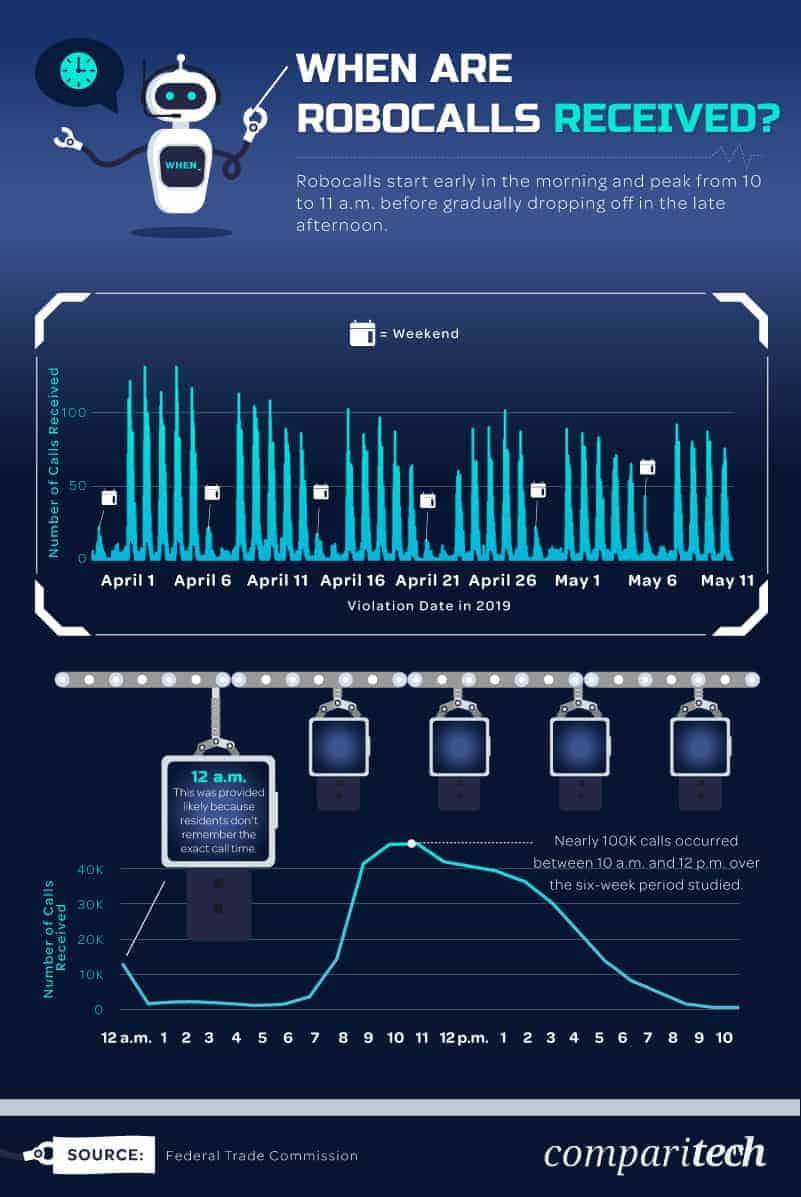
Robocalls are known to bother people frequently and at painfully inconvenient times. However, based on complaint data collected by the FTC, people were much more likely to report robocalls during the week than on the weekend. This could be due to a sharp decline in robocalls, or it could be because those who would normally report robocalls have better things to do with their Saturday and Sunday.
Nevertheless, robocalls tended to start pestering people bright and early. An hour-by-hour look at robocall complaints revealed a steep increase in calls starting at 7 a.m. when people are often waking up or getting started on their commute to work. These calls peaked around 10 to 11 a.m. and then slowly declined in the evening at around 8 p.m. There’s no doubt about it: Robocalls are likely disrupting your sleep, commute, meals, and even your evening dog walk.
Most Bothered Counties

People all around the U.S. might be getting harassed by spam robots, but not everyone is keen on going the extra step to report it. We analyzed FTC data to see which parts of the country were most likely to register a complaint.
Los Angeles, California, was the leading county when it came to the sheer count of robocall complaints with over 95,458 recorded in 2018. Citizens in Maricopa, Arizona; Cook, Illinois; and San Diego, California, didn’t seem too happy either – in each of these counties, more than 47,000 people complained about robocalls. However, when it came to the most complaints reported per capita, El Paso, Colorado, lead the pack, followed by Sangamon, Illinois, and St. Louis, Michigan.
Robotic America
Robocalls are causing Americans to download call-blocking apps, seek revenge on spammers, and even avoid the phone altogether. Perhaps no headline sums up much of the populace’s frustration than that of The Washington Post: “Die, Robocalls, Die.” But even so, robocalls are becoming an increasing part of our everyday reality in this highly automated world.
We examined data from the FTC to uncover the mysteries of where and why this is happening and what we can expect on the phone. Our analysis uncovered the sheer prevalence of robocalling and the possible uptick in dissatisfaction as more citizens report these spam calls.
To learn more about the tech of our time and how it could affect your life, visit Comparitech.com.
Methodology
The data utilized for this study are public and readily available on the FTC’s website. Two types of data were used for this deep-dive on robocalls. First, the FY 2018 Data Book was used. Second, the daily data log of the last six weeks, spanning March 30 to May 10, 2019, of the Do Not Call Reported Calls Data was used. In most cases, the data were filtered for robocalls only, as live call data were often provided as well.
Sources
- https://clutch.co/call-centers/answering-services/resources/how-common-are-robocalls
- https://www.fcc.gov/document/fcc-affirms-robocall-blocking-default-protect-consumers-0
- https://www.inc.com/melanie-curtin/are-you-on-your-phone-too-much-average-person-spends-this-many-hours-on-it-every-day.html
- https://www.theverge.com/2019/1/30/18203413/robocalls-spam-text-calls-2018-analysis-hiya
- https://www.consumer.ftc.gov/articles/0133-cell-phones-and-do-not-call-registry
- https://www.nbcnews.com/news/us-news/robocall-epidemic-2018-how-bad-robocalls-are-what-you-can-n921206
- https://www.theverge.com/2018/1/1/16837814/robocall-spam-phone-call-increase-2017-ftc-report
- https://www.washingtonpost.com/technology/2019/04/04/die-robocalls-die-how-to-guide-stop-spammers-exact-revenge/?utm_term=.da44f9d43d19
- https://www.wsj.com/articles/everyone-loathes-robocalls-some-people-try-to-get-even-11545321458
- https://www.comparitech.com/blog/vpn-privacy/phone-spam-case-study-data/
- https://www.reuters.com/article/us-cvs-health-aetna-connecticut/cvs-plans-to-keep-aetnas-headquarters-in-connecticut-idUSKBN1F12H2
- https://www.vox.com/the-goods/2019/6/7/18656761/fcc-vote-block-spam-calls-automatic-robocall
- https://markets.businessinsider.com/news/stocks/most-people-receive-one-or-more-robocalls-per-day-new-survey-finds-1027759103
- https://www.comparitech.com/blog/information-security/phone-spam-statistics/
Fair Use Statement
Robocalls can be overwhelming, and many people don’t know just how common they are or that there are resources to help. If you wish to share our report with those who would be interested and it is for noncommercial purposes, we ask only that you link back to this page so that our authors can be properly credited for their work.



I have drastically cut the number of robocalls I get. I am an electronics designer quite familiar with programming and computer control. I built a solution and it works. I connected it to the phone line between the phones and the outside line. When a call comes in, the system picks up immediately after the first ring and states “This is an automated phone system. Press (a number which changes) to complete your call.” Since robocalls cannot press numbers the call dies and the system disconnects after 5 seconds. My phones never rang so I was not disturbed. (But just for the record, since the caller ID signal is sent after the first ring, the system does keep a log of all calls whether accepted or not.)
But suppose it is a real call. The caller presses the requested digit and the system passes the call on though. It generates a ring signal to cause the phones to actually ring just as they would if the phone company sent the signal. I simply answer the phone and talk. Likewise if I’m not home, the answer machine will respond just as it would to any unanswered call; take a message after the beep, allow remote control, etc. The only difference is the number of rings the caller hears. Because the first ring is always suppressed, the caller hears the phone has rung 5 times when in reality I only hear 4. Not normally an issue.
Frustrated by the cumbersome screening service offered by my provider, and driven to near madness by robo calls, I bought a device that plugs into my ‘phone line. It came pre-loaded with 10,000 numbers that are associated with nuisance calls, with the ability to manually load others. (For me, this feature does not seem to work… I’ll contact their support on the matter.) The device is a godsend. It cost a bit over a hundred bucks, but I was paying my provider about $40.00, so the device will pay for itself in three months. Aside for the afore-mentioned glitch, it works like a charm!!
I gave up complaining to the FTC years ago…total waste of time. I’m sure others have too.
One thing is for sure, robocalling will continue to grow and get much much worse.
This reason being is that there are no criminal penalties. NOT one scammer has ever been arrested or jailed for making robocalls. Ever.
The FTC simply sues them and assesses a fine. But the scammers just ignore the fines and continue calling. Imagine if you never had to pay your speeding tickets. It’s the same concept with robocalling. Plain and simple, phone scammers must face jail time for robocalling.
This article ignored what I consider the most common thread of these calls, the country of origin. The vast majority of these calls come from India. India needs to take the lead in shutting down these call centers.
Maybe these might help?
Unrecognized number, pick up, but DO NOT say hello. Just let the silence run/put the phone down until they hang up. Don’t make any noise which might trigger a computer on the other end listening for a voice, letting them know the line is owned by someone.
or…
Develop a persona – like a pirate, senile old bat, mobster, etc.
Get to a human and act like a complete dweeb. Sometimes they laugh and hang up. Sometimes they get mad! If they are obviously foreign (like IRS Agent with Indian accent) say your name is something like Grover Cleveland or someone else only an American is likely to recognize.
Anyway, I’m down to average one robocall a day now. Not sure if it’s related to the above or not. I was just starting to have fun with them too.
I have a landline it only let’s me block 30 numbers, fix that to allow me to block 100k and I solve my problem.
Robocalls are like the ethylene put in your gas. Both should be outlawed but they are powered by big money.
.
The crowdsource technology to solve this problem has been available for years, but the phone companies are incentivized by the money they make from every completed call to slow-roll the FCC, FTC and Congress into believing it’s complicated and government should take a light touch. Phone companies should no longer be believed and government needs to stop tip-toeing around the issue.
98% of my incoming calls are from people or institutions that I have NO INTEREST in speaking with. I’ve been on the useless “No Call List” for years. Sadly, I have resorted to screening ALL my calls. If I do NOT recognize your name or number on my caller I.D. then you don’t stand a snowball’s chance in hell of me picking up the phone.
Your statistics about complaints do not reflect the fact that most people know it to be useless. Why would they waste their time. More discussion about why the carriers and our legislators do not fix this would be more useful
I get so many numbers I don’t recognize – mostly about Microsoft or Medicare calls. Recently on Saturday and Monday, I received calls which were identified as myself – my name and telephone number. I called FCC.
These calls will not stop till we locate these call centers, arrest the managers, and seize all their phones and computer equipment. Get the NSA to set up some phone lines and trace the calls back to their physical location. If they’re in a foreign country, demand that they be shut down or we’ll give the call center 10 minutes warning and then hit it with a Hellfire missile.
Also arrest the people working the phones and allow them to plead guilty to a misdemeanor with a suspended sentence. Tell them if they’re caught doing it again, they’ll get a year in a penitentiary.
Politicians ,Dems and are pubs get campaign contributions from major carriers ergo they not interested in putting callers out of business because of carrier revenues in the millions for using their lines.
Stop calling me. I do not, and will not ever, purposefully communicate in the English language with robots. I blame mobile devices and social networking. That’s why I use neither of those. The 40 dollar, 10,000 number capacity, sentryz call blocker is the product of choice for landline consumers. Rings once than hangs up. Nearly 700 blocked numbers and counting in only a few years. Keep on calling, I’ll keep on blocking. Pay to use apps are a gimmick, eventually they will go the way of ad block and allow sponsored pay to bypass the gatekeepers. My analog blocker, it does what I tell it to, no exceptions. And I own it and only pay once.
There is an easy way to avoid these calls if you have a cell phone. You can download an app that allows your phone to ring only when it is someone in your phone directory. All other calls are blocked but they can leave a voice mail. Therefore, if someone is trying to get ahold of you, they can leave a message. I get at two or more calls that are blocked every day.
Kind of a worthless article. Your main point is that all the statistics you reference show that robocalls are prevalent. Guess what? We already knew that. Who needs data to underpin what we already intuitively know? You don’t even mention anything about the mechanics of robocalls. How they get your number. The huge rise in cell phone robocalls as people cut the cable. Who you call to complain. How robocall companies rent local exchanges for a few seconds at-a-time to make the calls appear to be local. The fact you can’t say “take me off your list” to a machine. The fact that people are missing critical call-backs from their doctors because they think it’s another robocall. How hospitals and EMT’s are getting their critical phones clogged with robocalls. How companies get away with calling people who are on the Do Not Call database. Your article is of more use to the people who are harassing us that phone users. You’re telling them where we don’t complain, and where they can move to unsaturated markets. thanks for having our back. Not. Oh, ironic that at the bottom of this comment window, there’s one of those little “I’m not a robot” check boxes. Where is ours?
What has worked best for my household: We have installed our own call blocking, caller ID and voice mail technology. Only calls from approved numbers are answered by a live person. The rest are routed to voice mail. Most of the calls routed to voice mail disconnect. Few leave messages. Legitimate callers will leave messages and their calls returned. Over the past 2.5 years 475 numbers have been identified as robo, spam, etc., and are permanently blocked.
Only answer calls that show they are from people in your contact list. If they are not in your contact list but you know them, they will leave you a voicemail. Don’t answer the calls otherwise. Problem solved.